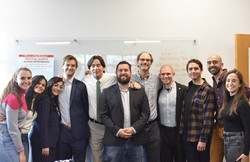The University is looking to provide other on-campus dining options through possible contracts with other food providing companies to assist in the supply and demand of the campus community. ARAMARK, the present contract holder, is still being considered as well.
According to Mary Anne Nagy, Vice President for Student Life and Leadership Engagement, the University has been using ARAMARK and their services for over 35 years. But while the use of ARAMARK has remained consistent, so has the steady rise in costs.
“I can’t recall within the last five years when we haven’t had a price increase. We’ve not had a price decrease because, as you know, with rising costs in energy, food, labor, [and] health care that’s now required as a result of the Affordable Care Act, prices go up,” said Nagy.
Nagy added that while prices might be going up due to the outside factors that often inflate the economy and prices of goods, these are factors that affect the costs of food everywhere. But every time there is a price increase, as determined by ARAMARK, there is a whole process that goes behind justifying the price change before it is approved.
There are two renewable periods in which ARAMARK submits bids to the University that essentially goes over every one of their prices, including the increases, Nagy said. “In both instances ARAMARK proposes a price increase and it could be across the board, it could be on certain products, it’s really up to them but they have to explain why,” she said.
The next step, Nagy added, is the University starts to benchmark the pricing of similar items off-campus in the area to determine whether the proposed on-campus price is reasonable; as she puts it there has to be a comparison of “apples to apples.”
Mark Vallaro, ARAMARK Senior Food Service Director, said that the company conducts a market price analysis twice a year to make sure that they are price conscious with their merchandise. “Our pricing strategy includes comprehensive competitive shopping,” said Vallaro.
“We obtain pricing from local establishments with similar products, other area colleges and universities, and local convenience stores before marketing any of our items… Additionally, each of our convenience stores carries an updated market price analysis. Our direct store delivery products, such as bottled beverages, chips, candy, sandwiches, etc. are competitive with the products sold in convenience stores off campus.”
According to Hannah Simmons, a senior political science major, food costs on-campus can vary and range from reasonable to above-average. “It all depends on what you get and where you go,” said Simmons, “For me personally, I normally head to the [Rebecca Stafford] Student Center (RSSC) because that is most convenient for me. Most days, I usually go with a salad, and I consider that to be very affordable. However, sometimes I like to splurge and go with Jersey Mikes for a change. I have found that those subs can get a little pricey depending on the size you go with, plus if you want chips and a drink the cost for lunch that day will add up.”
Mike Hamilton, a senior political science major said, food pricing isn’t as much as an issue as the actual food is. “I think the pricing is reasonable, but the quality is definitely worse than going off campus to eat,” said Hamilton. He added that the lines are also an issue and often deter students from being able to purchase food before class.
Several students, including Hamilton and Simmons, believe that the line problem surrounding the food stands, particularly in the RSSC are due to lack of availability of food choices.
“[Of course] there are peak times and dead times, and you can’t keep employees busy all the time, but then you risk getting rid of staff and having less employees to work during peak hours,” said Nagy. She added that on the other end of the spectrum there is the risk of hiring more employees and not enough space to have them operate in.
With working space possibly being an issue, Nagy also added that the volume of students needing to be served at any time is another added obstacle. She estimated that anywhere from 17-18,000 meals are served per week, through an estimated 9 on-campus retail companies, taking about 20 hours a day to accomplish.
Nagy said in order to satisfy the growing demand for affordable and high quantity of food items, Monmouth is looking into four other food service companies, one including ARAMARK, to possibly feed the campus population.
To Jess Ketch, a senior duel psychology and sociology major, the prospects of having more options on-campus would be great price-wise. “More kiosk locations would be really helpful like the one in Bey Hall, the only problem is that the one in Bey is the only one…I feel like both outdoor and more indoor kiosks in the academic buildings would be cool to have, and more beneficial to everyone on-campus and not just those who happen to be by it, like the situation in Bey,” said Ketch.
Recently the University has employed an updated convenience store on the bottom floor of the New Hall dorm that some feel satisfies the need of a quick place to go and grab something to eat. Rachel Gramuglia, a senior communication major and resident assistant, said that it’s a great location for people on the residential side to get simple and fast-to-make dinner but is concerned about the price of convenience. “It’s nice seeing another dining option on the other side of campus other than SHADOWS, but I think it’s a little bit expensive; almost as expensive as a CVS,” said Gramuglia.
She added that the primary complaints that she has heard from those in her dorm concerning the store is “that the store reads as more of a supermarket than a convenience store with marked up prices to match.”
According to an article by Megan Warmouth featured on The Foodservice Director website, several colleges are taking the steps to allow more brand-name companies operate quick-to-serve stands and kiosks on-campus. “Quick-serve and fast-casual street brands have pretty much always been available to them [the students],” wrote Warmouth, “And with more ethnic and global options than ever, comfort food for this group runs the gamut from burritos to wontons. Offering variety and unique food options is merely a means of meeting student expectation.”
In order to keep up with the changes taking effect on campuses everywhere, Vallaro said ARAMARK is preparing to reach out for student feedback to see what they feel is missing in their University dining experience. “On this campus, we are conducting a survey this fall and will certainly take the results and feedback into account when making adjustments to the dining program, including pricing structure and venue offering,” said Vallaro.
PHOTO COURTESY of Kiera Lanni




